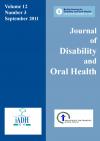Journal of Disability and Oral Health

- Cover Date:
- September 2011
- Print ISSN:
- 1470-8558
- Vol:
- 12
- Issue:
- 3
Editorial - Paradigm shifts and the ICF model
Journal of Disability and Oral Health (2011) 12/3 98
Editorial - Paradigm shifts and the ICF model
A paradigm is a set of assumptions, concepts, values and practices that constitutes a way of viewing reality. The dominant paradigm in health has undergone a massive shift in the last 20 years. The ubiquitous medical model that revolved around disease management was revolutionised by concepts of quality of life and the behavioural aspects of health. Further evolution has reached beyond the realm of the individual into the domain of the social determinants of health (Marmot & Wilkinson, 1999) and the concept of universal human functioning (Bickenbach et al., 1999). In the domain of disability, this change has been particularly palpable in the WHO system of classification (Stucki & Grimby, 2004). The original International Classification of Impairment, Disability and Handicap (WHO, 1980) described a linear model with a disease or disorder leading directly to impairment then disability and handicap. The current International Classification of Functioning (ICF: WHO, 2001) abandons the negative connotations of impairment and handicap. It is a complete classification of human functioning in terms of body function and structure, individual activity, and participation in society. These dimensions are modified by environmental and personal factors. Disability is thus not considered an illness but is defined according to how a person fulfils his/her normal social role within a given environment. It is universally applicable to all persons, with or without a declared disability, and critically, recognises the major influence of environment on human function. Why is this paradigm shift so important in the context of disability and oral health? We are all aware of the major inequalities in oral health experienced by persons with disability. Many of our efforts, as a profession, have been directed at providing services to reduce the overwhelming volume of unmet need in terms of disease management. It is time we stopped dealing solely with disease and started to address the wider determinants of inequality. The ICF provides a model around which to conceptualise this change. It allows us to perceive our patients, not in terms of medical diagnosis or DMF, but in terms of how well they are able to eat, drink, talk, participate in meals, and more importantly, what factors in their social environment impact on this ability to function successfully. It is only by identifying these influences, at individual and population levels, that we may reduce inequalities in relation to the social determinants of health and in relation to the prevention of oral dysfunction and disease. So how can special care dentists help to reduce inequalities through paradigm shift?
- Article Price
- £15.00
- Institution Article Price
- £
- Page Start
- 98
- Page End
- 98
- Authors
Articles from this issue
- Title
- Pg. Start
- Pg. End
- Evaluation of noncavitated and cavitated carious lesions using the International Caries Detection Assessment System (ICDAS II) and oral hygiene in Thai students with disabilities
- 99
- 106
- The use of applied tension to manage orthodontic extractions in Blood-Injury-Injection Phobia: a case report
- 121
- 123
- Dental treatment for a patient with motor neurone disease completed under total intravenous anaesthesia: a case report
- 124
- 127
